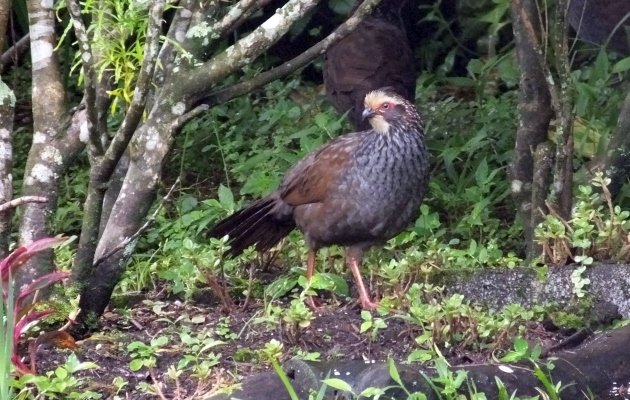
Grouse are the chickens we would love to lay eyes on. “Gamebirds” to some, cool, cryptic understory birds to the birding people, grouse crouch protected as unfettered winds sway the top of the tall prairie grass. Other grouse give booming calls from the interior green of cool, coniferous forest, another picks its way through treacherous scree, thriving in the harsh reality of high mountain passes. Then there are the ones that live in PA , the state bird, “the grouse” that a great many non-birders are aware of, my Uncle Fred was one of them.
Much more an outdoorsman than a birder, Fred tended to stick to the bigger birds. Even so, he still knew many species and always yearned to learn about the wildlife he encountered. “I don’t know those small birds too much, I think the big ones are more my style” (after my 10 year old self eagerly told him about my lifer Yellow-throated Vireo). Knowing of my interest in birds, he was pleased to show me the first major field guide I had ever seen, the “Birds of the Eastern Region: National Audubon Society Field Guide”. “I like it, Patrick, because it has photos of the birds. Groups them by family too and by their shape”. His extra long arm extended and passed me that precious book. “Check it out!” Ever the skilled craftsman, Fred had personalized the tome with Velcro and a supple leather book strap. Already a birder at 7, I was enthralled by the images and discoveries waiting inside those pages. There wasn’t just one gull but many, including the odd and elegant Sabine’s! There were multitudes of warblers, too many birds to look at. There were also grouse, the Ruffed Grouse, and like so many other species, it just seemed impossible that I would ever see one.
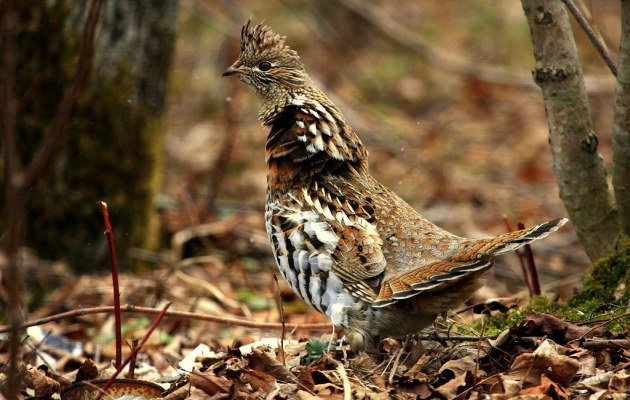
“Ruffed Grouse” by seabamirum is licensed under CC BY 2.0
I assumed that the camouflaged crested gamebird must be a bird of the deep forest, of the wild places and so how could you ever see it? Those were the far away places, unimaginably far beyond the horizon. You have to understand, living in an urban neighborhood, “the country” was completely out of reach. I figured that the birds were somewhere out there but mostly beyond my grasp. They were waiting in the wild places but how could I get there? I sometimes studied maps, imagining what those wild places might be like, the birds that might live there. At 8, everything was far away, distant, and foreign, even Pennsylvania.
Fred talked to us now and then about the wild and wooded state. Not about the City of Brotherly Love, not about the Steelers or Penguins, but about forests with deer, birds, and elbow room. He and Christine had a cabin there, out in the woods and one fine day, my brothers and I found that we were going to visit. We were going to make the long drive to far away Pennsylvania and stay in the cabin for a few precious, amazing days. I had no idea what it might be like, I wasn’t sure which birds would be there but I knew there would be a lot. It was the real woods after all, not some local park with a few scattered and domesticated oaks nor city streets where we tried to trap pigeons with cardboard boxes. The cabin was in a bona fide, guaranteed wild place, and was, therefore, undisputedly, incredibly exciting.
Needless to say, that first of several trips was an eye-opener in many respects. Indigo Buntings became real but looked black in a certain light. Wood-warblers lived in those Appalachian forests, many of them! Most of the birds were new (this was the real of my real forests after all), some lifers were unexpected. One such surprising experience happened with grouse.
The grouse connection occurred during a “walk” from the cabin to some other part of Fred and Chris’ property. I daresay Fred wanted to do the hike more than we did but being kids before the digital age, we were always game for outdoor adventures. By way of prickly pain, we quickly discovered that blackberry brambles were sort of abundant, and that wading through the understory was a soaking wet process (even with Fred’s 6 foot 6 frame clearing some of the way). We also found that just one of Fred’s strides was equal to three or four of our steps (although he made sure to never get too far ahead of us).
As we steadily waded through the wet and thorny understory, whether because of blackberry scratches capturing most of my attention or maybe because the birds didn’t want to share our explorations, I don’t recall all that much of the avian kind. The perceived absence of birds, though, was just setting up the birding stage for the feathered star of the mid-day show. In keeping with gamebird tradition, my first experience with grouse wasn’t one of a bird on a branch or something singing from a tree. It happened with an explosion of clattering wings, a sudden feathered football that burst out of a small clearing in the brush; first one and then another, and then five, six birds that flew in front of, over, and between us!
I admit, they took me by surprise and I’m not sure if I would have known what the heck was going on if Fred hadn’t made the announcement. Like a herald of the woods, arms stretched way out and nearly flapping with excitement, Fred’s deep voiced complemented the clapping of wings. “Grouse! Ruffed Grouse! Ruffed Grouse!” Feathered footballs flew everywhere as Fred strode among the birds, inadvertently welcoming my lifer Ruffed Grouse, my first of the Phasianidae, a bird unexpected and welcomed.
Fast forwarding to Costa Rica, to be honest, you won’t find any grouse around here. Not any true grouse for that matter; in these lush tropical woods, the Phasianidae just didn’t make their evolutionary mark. Perhaps they couldn’t hack it, terrestrial niches were taken up by other birds. Competing with well adapted tinamous would have always been tough, the same goes for a related yet separate family of very grouse-like birds; the New World Quails.
Have you heard the whistle of a Bobwhite? Seen one scurry along a weedy forest track? If so, you have connected with one of the Odontorophidae, a family of birds that reaches its northern limit with the bobwhites that have declined in so many southern brushy fields and piney woods. Further south, several of these cool, tropical wild chickens evolved to inhabit a variety of tropical forests, in Costa Rica, we have been honored with seven of them.
One is a tropical bobwhite that acts and sounds pretty much like the other bobwhites, another is a wood-partridge that acts and looks more like Asian bamboo partridges than anything, and there is the rare and super tough Tawny-faced Quail. The remaining four species are the most grouse-like of the bunch. In keeping with their non-grouse taxonomic status, they are called “wood-quails” and we have one for each type of wet, tropical forest.

Like my Uncle Fred’s grouse, they forage on the ground, creep among the vegetation, and have cryptic patterns and colors that help them escape detection and survive. However, seeing them doesn’t involve flushing them from the undergrowth. These “grouse” could be too sneaky for such heavy-handed, accidental strategies. They also tend to live at low density populations. A better way to see the wood-quails is by listening for their rollicking covey calls, usually given in the early morning. That way, you can at least know where the cool chickens are hanging out, at least know where to carefully watch for them.
Even knowing where the tropical pseudo-grouse are, they can still be elusive. Although wood-quails can flush, they would rather quietly sneak off or just sit and let the camo do its work. They also hide all too easy in the dark understory of tropical forest. Seeing them is a function of luck and birding with a quiet, concentrated mind but at least two of the species in Costa Rica are easier than the others.
The easiest of the wood-quails in Costa Rica is the Spotted Wood-Quail. A common bird of high elevation oak forest, you might find them while birding in the Talamanca Mountains. Watch and listen for the birds as they rustle through the leaf litter.
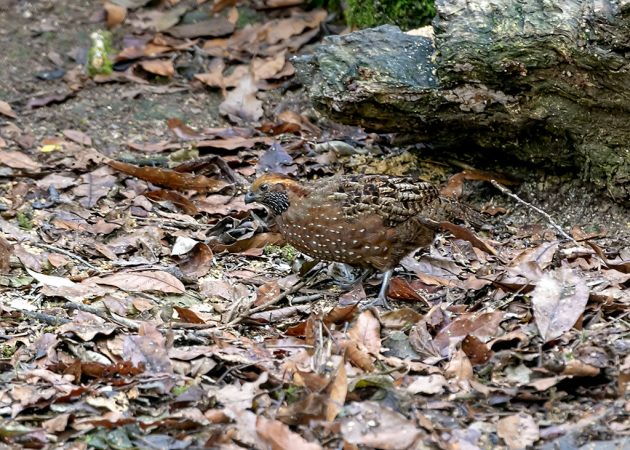
“Spotted Wood-quail” by chaz jackson is licensed under CC BY 2.0
Stalk trails in Monteverde and other cloud forest sites and you might find Black-breasted Wood-Quail. This one is also fairly common, especially around Monteverde.
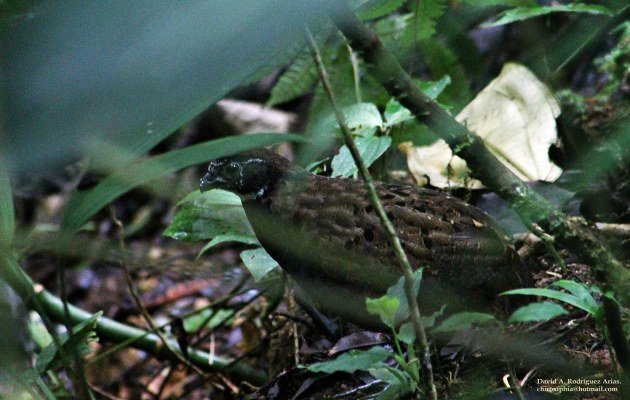
“Odontophorus leucolaemus_” by David Rodríguez Arias is licensed under CC BY-NC-SA 2.0
At lower elevations, we have our final, more challenging pair of wood-quails; the Marbled in the rainforests of the southern Pacific slope, and the Black-eared in the wet forests of the Caribbean side. Both can be a challenge and require patient Zen birding in the right places. The Marbled might be slightly easier but I wouldn’t call it simple.
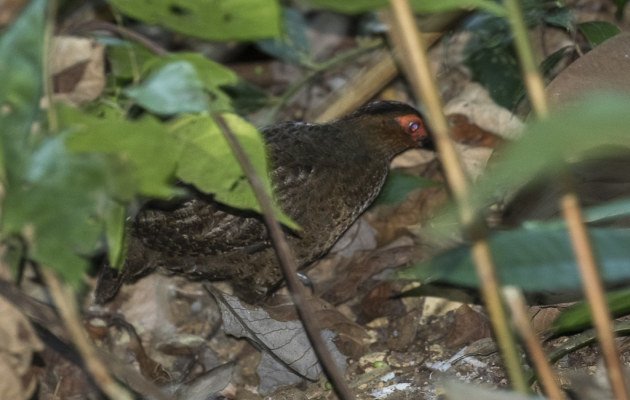
“Marbled Wood-Quail – Rio Tigre – Costa Rica_MG_7758” by fveronesi1 is licensed under CC BY-SA 2.0
The Black-eared is decidedly uncommon, seems to be highly susceptible to edge effects, and because of its quiet and extra careful ways, is probably easier while birding on your own. I’m sure that solo birding helped me see my first of this difficult species. In contrast to the primary grouse experience, seeing the extra shy Black-eared Wood-Quail involved quiet and careful stalking on a trail in mature foothill rainforest.
As usual, a cicada or two droned on and off, on and off as the small mosquitoes inspected and wondered if they should bite. White-breasted Wood-Wrens called from the dark undergrowth and tanagers chipped from high above. Blackberries and cool weather forest was replaced by spiny palms, huge mossy leaves, and constant humidity. Bushwacking? Not in this place. Not needed and with hidden wasp nests and five species of highly camouflaged vipers somewhere out there in the leaf litter and blending in with low vegetation…not the best of ideas.
Slow, careful walking on the trail still turned up many birds and one rare day in the 90s, it gave me a covey of coveted Black-eared Wood-Quails. They didn’t explode into flight, didn’t drum or do any other grouse moves. I only saw them because I heard their quiet, whistled calls. I had no idea what was making that soft chippering noise, had no idea but imitating those calls seemed to bring them my way, bit by bit. I had to wait long enough for the mosquitoes to settle in and bite, to be nearly hypnotized by the droning of the cicadas but eventually the mystery birds crept into view. With what seemed to be extreme caution, they slowly moved into sight, raising and lowering their orange crests as they ninja walked onto the trail. Not that grouse have any lack of enemies but these wood-quail have to avoid vipers, and other snakes, the forest cats, forest-falcons, and other raptors, all of which are just as adept as the wood-quail at staying hidden.
The wood-quail walked within a few meters, at the time, I didn’t realize how rare and unusual my sighting was. As they snuck away and melded back into the rainforest, I whispered their names. Fred would have been proud.













Leave a Comment